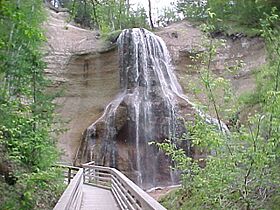Smith Falls facts for kids
Quick facts for kids Smith Falls State Park |
|||||||||||||||
|---|---|---|---|---|---|---|---|---|---|---|---|---|---|---|---|
 |
|||||||||||||||
| Lua error in Module:Location_map at line 420: attempt to index field 'wikibase' (a nil value). | |||||||||||||||
| Location | Cherry County, Nebraska, United States | ||||||||||||||
| Nearest city | Valentine, Nebraska | ||||||||||||||
| Area | 265.5 acres (107.4 ha) | ||||||||||||||
| Elevation | 2,333 ft (711 m) | ||||||||||||||
| Established | 1992 | ||||||||||||||
| Administered by | Nebraska Game and Parks Commission | ||||||||||||||
| Designation | Nebraska state park | ||||||||||||||
| Named for | Orrin B. Smith | ||||||||||||||
| Website | Smith Falls State Park | ||||||||||||||
|
|||||||||||||||
Smith Falls is Nebraska's tallest waterfall, standing at 63 feet (19 meters) high! It's the main attraction of Smith Falls State Park. This beautiful park and its waterfall are found in Cherry County, Nebraska, near the towns of Valentine and Sparks.
The park is located on the south side of the Niobrara River. You can reach the falls by crossing a special footbridge over the river.
Contents
Discovering Smith Falls State Park
Smith Falls State Park is a wonderful place to explore nature. It was officially created in 1992. The park covers about 265.5 acres (107.4 hectares) of land.
The History Behind the Name
The waterfall was first known as Arikaree Falls. Later, it was named after Orrin B. Smith, an early settler in the area. His step-son, Frederick Smith, claimed land on the south side of the river in 1889.
Fred Krzyzanowski bought the land in 1941. He added picnic areas and a campground for visitors. The Nebraska Game and Parks Commission then leased the land from the Krzyzanowski family. This is how Smith Falls State Park was established in 1992. A new lease was signed in 2018, ensuring the park remains open for many years.
The Historic Footbridge
In 1996, a special bridge was moved to the park. This bridge, called the Verdigre bridge, was very old. It used to carry traffic on Highway 14 in the village of Verdigre.
Workers carefully took the bridge apart in 1991. Then, they rebuilt it in the park as a 160-foot-long iron truss footbridge. Now, it helps visitors cross the Niobrara River to reach the falls.
Unique Nature at Smith Falls
The falls are fed by a short stream that flows into a small canyon. This canyon is cool and shady, unlike the sunny Sand Hills around it. Because of this, some very special plants grow here.
Plants from the Ice Age
Long ago, about 10,000 years ago, Nebraska was much colder. This was during the Wisconsin glaciation, a time when glaciers covered parts of North America. The cold climate allowed trees like paper birch, spruce, and aspen to grow. These trees are now mostly found in Canada.
As the glaciers melted, Nebraska became warmer and drier. Most of these "boreal forest" trees disappeared. However, the cool canyons along the Niobrara River acted like natural refrigerators. They protected some of these ancient trees.
Surviving Species and Their Future
While spruce trees did not survive in Nebraska, some paper birches and aspens did. They live in the cool, sheltered spots of the canyons. These small areas are called microclimates.
However, these special trees are now facing a new challenge: warming temperatures. The paper birch trees around Smith Falls are not having new baby trees. Scientists are worried they might disappear in the future.
Fun Things to Do at the Park
Smith Falls State Park offers many activities for visitors.
- You can go tent camping and sleep under the stars.
- Canoeing on the Niobrara River is a popular adventure.
- Fishing is also allowed for those who enjoy it.
- There are hiking trails to explore the beautiful scenery.
- You can also have a picnic with your family and friends.
See also


